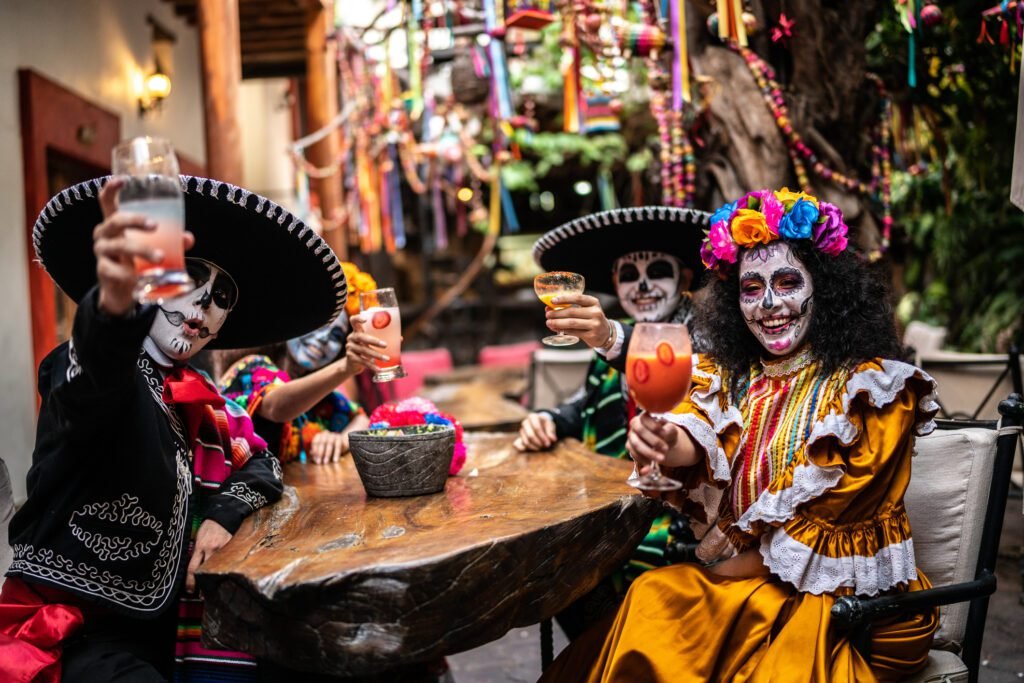Día de los Muertos: A Unique Celebration of Life and Death in Mexico
“Día de los Muertos: A Unique Celebration of Life and Death in Mexico” explores the rich and vibrant tradition of Day of the Dead in Mexico. This ancient and sentimental celebration is deeply rooted in Mexican culture, serving as a reminder to cherish and celebrate both the deceased and our own lives. With its unique blend of mourning, remembrance, and joy, Día de los Muertos brings families together in a quintessential Mexican celebration filled with food, music, and love. As the article dives into the details, it reveals how this tradition has evolved over thousands of years and highlights key elements such as setting up altars, visiting cemeteries, using marigolds, preparing traditional food, and even getting your face painted as a skeleton. Additionally, the article showcases special events across different parts of Mexico, where the Day of the Dead is celebrated with grandeur and community participation. Get ready to explore the vibrant and enchanting world of Día de los Muertos.

This image is property of lp-cms-production.s3.amazonaws.com.
When is Día de los Muertos?
While preparations and some regional celebrations begin in mid to late October, Día de los Muertos takes place on two specific days: November 1 and 2.
The first day focuses on children who’ve died and is called Día de los Inocentes (Day of the Innocent Ones – not to be confused with Mexico’s version of April Fool’s Day on December 28) or Día de los Angelitos (Day of the Little Angels).
The second day is centered around adults and is called either Día de los Muertos or Día de los Difuntos (Day of the Departed). Originally celebrated in August during pre-Columbian times, it evolved to coincide with the respective Catholic holidays of All Saints’ Day and All Souls’ Day, two days of prayer and remembrance for the deceased.
Set up an ofrenda (altar)
Beginning in mid-October, many Mexicans set up ofrendas (altars) in their homes and businesses for loved ones who have passed. Ofrendas can be simple displays or elaborate multi-level affairs, but all share the same elements: photos of the deceased, food and drink they enjoyed in life, and small items they loved (say, a toy, a bottle of nail polish, or a book).
Commonly displayed items include candles, flowers, crucifixes, and colorful images of saints. For many, the ofrenda represents a family’s remembrance of someone they loved; for others, it represents a homecoming, a place for their family’s spirits to return to during this time of year.

This image is property of lp-cms-production.s3.amazonaws.com.
Head to the cemetery
Regardless of regional differences, Día de los Muertos is a time when Mexicans go to their cemeteries to clean the graves of their loved ones and decorate them with flowers and candles.
The energy is often both festive and respectful, with families bringing folding chairs and blankets to settle in for a day, and even a night, of food, drinks, and storytelling. Live music is common, and musicians will wind their way through the cemeteries, stopping at gravesite after gravesite to play the favorite tunes of the deceased.
Buy some flowers, particularly marigolds
Although all sorts of flowers are used during Día de los Muertos, the bright orange cempasúchil (marigold) is considered the official flower of the dead in Mexico.
Native to the central part of the country, it has been used in Day of the Dead celebrations since ancient times, as people believed its vivid hue and musky fragrance helped lead spirits back to their homes.
Today, marigolds remain popular for ofrendas and gravesites, especially in the central and southern parts of Mexico, where cemeteries transform into seas of orange, and marigold petals are strewn before altars in a nod to ancient beliefs.

This image is property of lp-cms-production.s3.amazonaws.com.
Prepare some food
Food is an integral part of Día de los Muertos. Ofrendas will feature the favorite foods of the deceased, representing not just their preferences but also different regional cuisines like mole negro (a slow-cooked sauce made with hoja santa chili, chocolate onions, and garlic, often served with chicken) in Oaxaca, pozole (traditional Mexican stew with shredded cabbage, chili peppers, onion, garlic, radishes, avocado, salsa, and lime) in Mexico City, and calabaza en tacha (candied pumpkin cooked in sugar cane syrup) in Yucatán.
One food that’s almost universally present, however, is pan de muerto (bread of the dead). This spongy, egg-based bread sprinkled with sugar comes in a round loaf with bone-shaped decorations – a representation of the cycle of life and death. Bakeries start selling pan de muerto a week or two before Día de los Muertos, both for use on ofrendas and as a sweet treat to enjoy with coffee, hot cocoa, or atole (a hot, corn-based drink).
Get your face painted as a skeleton
Skeleton imagery has become increasingly common in Día de los Muertos celebrations, largely due to the popularity of La Catrina, a high-society skeleton sporting a feather boa and an oversized Victorian-era hat.
Created in the early 1900s by the satirical cartoonist José Guadalupe Posada, La Catrina embodies the reality that death spares no one, rich or poor. The image was later adopted into the national psyche through the art of Mexican muralist Diego Rivera, among others.
Today, celebrations around Mexico highlight this most famous skeleton through paper mâché décor, candy skulls for ofrendas, and skeleton imagery in signage and papel picado (colorful, perforated banners) that flutter across streets.
On parade or procession days, many people paint their faces to appear as skulls and dress in colorful regional costumes or Victorian-era finery. Face painters often line the streets, ready to transform faces into skulls for passersby.

This image is property of lp-cms-production.s3.amazonaws.com.
Take part in a special event
Traditionally, Día de los Muertos is a family-oriented celebration, but larger-scale festivities, ranging from cemetery processions and city-wide parades to street fairs with food vendors and neon-lit rides, are taking hold all over the country.
Standout celebrations include:
-
Mexico City’s Desfile de Alebrijes (Parade of Spirit Guides). It kicks off in the Zócalo and winds through the capital’s streets. You can expect fantastical creatures, elaborate floats, and a crowd of thousands decked out in skeleton costumes.
-
Southeast of Mexico City, the streets of Mixquic are lined with Day of the Dead murals and people come from near and far for La Alumbrada (The Lighting), three nights when the town goes dark except for the cemetery, where thousands of candles light up the intricately adorned gravesites.
-
In the middle of Lake Pátzcuaro, Michoacán’s Janitzio Island is where thousands come to watch the arrival of flower-covered, candlelit canoes, kicking off a nightlong vigil/party at the town cemetery.
-
Oaxaca City’s week of festivities includes dance and music performances, graveyard tours, and a ‘best altar’ competition.
-
More than 50,000 people attend Mérida’s Paseo de las Ánimas (Procession of the Souls) – most in skeleton face paint and traditional Yucatecan dress. They then walk the two miles from the main cemetery to the town center, passing hundreds of candlelit ofrendas along the way.
In conclusion, Día de los Muertos is a unique and deeply heartfelt celebration in Mexico that combines mourning and remembrance with joy. It is a time when Mexicans gather to pay homage to their loved ones who have passed and celebrate the fleeting nature of life. From setting up ofrendas to visiting cemeteries, buying marigolds, preparing favorite foods, getting your face painted as a skeleton, and participating in special events, there are many ways to embrace and enjoy the rich traditions of Día de los Muertos.




